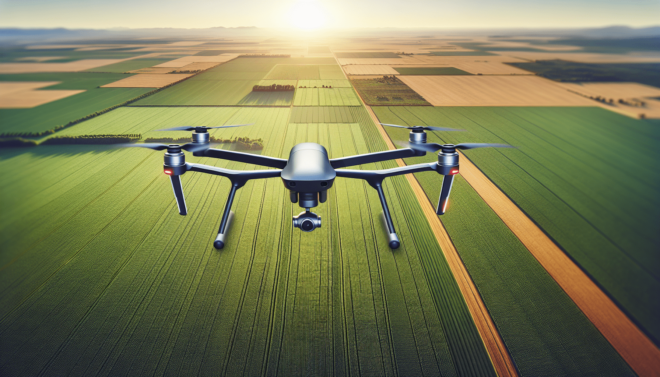What Is The Difference Between Fixed-wing And Rotary-wing Drones?
Introduction
You may have heard about the exciting world of drones and all the amazing things they can do. But did you know that there are different types of drones? Two of the most common types are fixed-wing and rotary-wing drones. In this article, we will explore the key differences between fixed-wing and rotary-wing drones, so you can better understand which type may be best for your needs.
Fixed-wing Drones
Fixed-wing drones are designed to resemble traditional airplanes, with wings that provide lift as they move forward. These drones are capable of flying long distances and staying in the air for extended periods of time.
Fixed-wing drones are ideal for surveying large areas and conducting mapping missions. They are commonly used in agriculture, construction, and environmental monitoring.
Pros of Fixed-wing Drones
Fixed-wing drones have several advantages that make them a popular choice for certain applications. Here are some pros of fixed-wing drones:
- Efficiency: Fixed-wing drones are more energy-efficient than rotary-wing drones, allowing them to cover larger areas in a single flight.
- Longer Flight Time: Due to their aerodynamic design, fixed-wing drones can stay airborne for hours, making them perfect for mapping and surveillance missions.
- Stability: Fixed-wing drones are more stable in flight, especially in windy conditions, making them reliable for collecting precise data.
Cons of Fixed-wing Drones
While fixed-wing drones have many advantages, they also have some limitations. Here are a few cons of fixed-wing drones:
- Limited Maneuverability: Fixed-wing drones cannot hover in one place like rotary-wing drones, making them less suitable for close-range inspections.
- Requires Runway: Fixed-wing drones need a runway or launch pad for takeoff and landing, limiting their usability in confined spaces.
Rotary-wing Drones
Rotary-wing drones, on the other hand, are designed with multiple rotors that provide lift and propulsion. These drones have a unique vertical takeoff and landing (VTOL) capability, allowing them to hover in place and take off from virtually anywhere.
Rotary-wing drones are commonly used for aerial photography, search and rescue missions, and recreational flying.
Pros of Rotary-wing Drones
Rotary-wing drones offer several advantages that make them a versatile choice for various applications. Here are some pros of rotary-wing drones:
- Vertical Takeoff and Landing: Rotary-wing drones can take off and land vertically, eliminating the need for a runway and allowing them to operate in tight spaces.
- Hover Capability: Rotary-wing drones can hover in one place, making them ideal for capturing stable aerial footage and performing close inspections.
- Agility: Rotary-wing drones are more maneuverable than fixed-wing drones, allowing them to navigate through obstacles and fly in all directions.
Cons of Rotary-wing Drones
While rotary-wing drones have many benefits, they also come with some drawbacks. Here are a few cons of rotary-wing drones:
- Shorter Flight Time: Rotary-wing drones have shorter flight times compared to fixed-wing drones, limiting their range and endurance.
- Less Energy-Efficient: Due to their design, rotary-wing drones consume more power during flight, reducing their overall efficiency.
Key Differences
Now that we have explored the pros and cons of fixed-wing and rotary-wing drones, let’s summarize the key differences between the two types:
| Fixed-wing Drones | Rotary-wing Drones |
|---|---|
| Energy-efficient and long flight time | Vertical takeoff and landing capability |
| Ideal for long-distance mapping missions | Suitable for close inspections and aerial photography |
| Requires runway for takeoff and landing | Can hover in one place and operate in tight spaces |
| More stable in flight, especially in windy conditions | More maneuverable and agile, suitable for navigating obstacles |
Which Type Is Right for You?
When deciding between fixed-wing and rotary-wing drones, it’s essential to consider your specific needs and the type of missions you will be conducting. Here are some factors to keep in mind when choosing the right drone for your requirements:
- Mission Duration: If you need to cover large areas and require long flight times, a fixed-wing drone may be the best choice.
- Maneuverability: For close inspections, aerial photography, or search and rescue missions that require agile flight capabilities, a rotary-wing drone may be more suitable.
- Operating Environment: Consider whether you will be flying in open spaces that allow for runway takeoff and landing, or if you need the flexibility of vertical takeoff and landing in confined areas.
Conclusion
In conclusion, the main difference between fixed-wing and rotary-wing drones lies in their design, flight capabilities, and suitability for various missions. Both types of drones have their own strengths and weaknesses, so it’s essential to evaluate your needs and choose the right drone for the job. Whether you opt for a fixed-wing drone for long-distance mapping missions or a rotary-wing drone for agile inspections, understanding the differences between the two types will help you make an informed decision. Happy flying!

